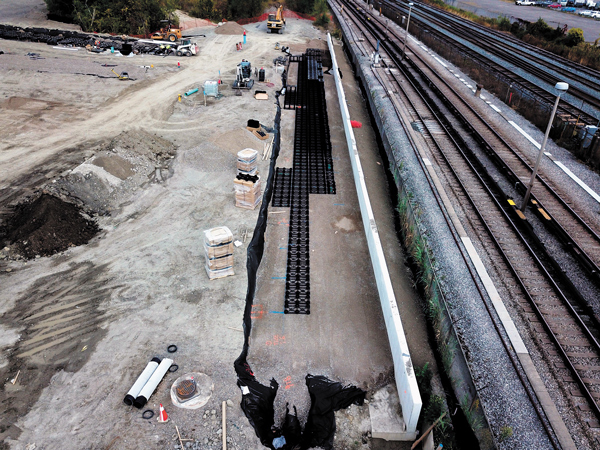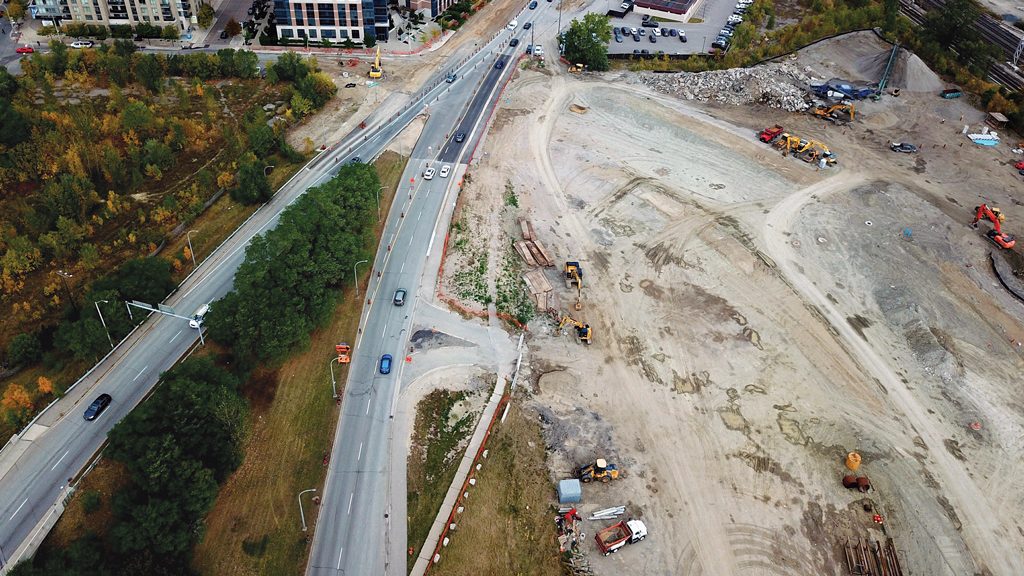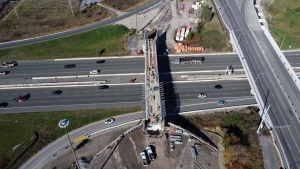A $70-million road project now in full progress in the west end Toronto suburb of Etobicoke is the culmination of more than 10 years of planning, consultation, engineering, and design.
It’s official title is the Six Points Interchange Reconfiguration, although the name doesn’t really convey the challenges and objectives of the project, which city officials say will transform the Six Points area into a more livable and vibrant community and less confusing to motorists.
Fermar Paving is the general contractor in charge of the project which involves multiple subcontractors, 40 to 50 workers, and between 15 to 20 pieces of heavy equipment spread over an approximately 17-hectare area on any given day.
Included in the long catalogue of work is a major realignment of one street, the opening of temporary connections, bus ramp closures, the relocation of utilities, and soil remediation on the site of a now-demolished movie theatre.
On top of those tasks, the contractor must keep the streets open in an area which has a daily traffic volume of almost 2,000 vehicles, is major bus transportation route, and home to one a subway stop and within close proximity of a second one.
This second phase started in 2017 and is scheduled to continue until spring 2020. A first phase conducted between 2014 and 2016 by Drain Star Contracting included site clearing, tree removal, and grading uneven lands.
The project consultant and contract administrator is WSP Canada Group Limited, while the detailed design was created by HDR Corporation which provides design consultation services when needed.
It’s one of the city’s largest projects in scope and complexity,
—Frank Clarizio
City of Toronto
“It’s one of the city’s largest projects in scope and complexity in respect to road infrastructure,” says Frank Clarizio, director of design and construction for Toronto’s transportation infrastructure department.
He uses the term “from interchange to intersection” to explain the overall goal of the project which will dramatically change the Six Points area—unofficially known as ‘Spaghetti Junction.’
The name is derived from the rather confusing interconnection of Dundas Street West, Bloor Street, and Kipling Avenue in the area just east of Highway 427. Bloor Street runs east-west and Kipling Avenue is a north south street, while Dundas crisscrosses through the area on an angle.
With ramps and bridges connecting those streets, the area has more of the appearance and feel of an express highway than an urban community, he says.
“It (the project) will return the area to normalcy.”
By that he means those bridges and ramps will be removed and the streets reconfigured to connect at signalized at-grade intersections.
The result will be new and/or improved pedestrian facilities consisting of wide boulevards, trees, and street furniture, plus improved access to the nearby to the Kipling subway station.
As well, the reconfiguration will free up land along the existing road right-of-ways for redevelopment and potential public uses such as parkettes and art exhibits.
One of the project’s most significant components is the realignment of Dundas Street West. It consists of building a new section through the old Westwood Theatre lands to connect with Bloor Street and then to the existing Dundas alignment.
Soil remediation of those lands was required before that phase of the project could proceed, says Clarizio, who wasn’t able to provide details on how extensive that remediation was.

New watermains, separate sewer and storm sewers are also being installed and there also considerable utility relocation by Bell Canada, Enbridge, and Toronto Hydro which is constructing a large underground duct bank along a portion of Dundas Street West. Some of that utility relocation began even before Fermar won the award for Phase 2.
This phase is so extensive that it has been divided into three stages, although Clarizio stresses that “there will be overlapping. It’s not case of one stage ending and then proceeding with the next one.”
A planned new Etobicoke Centre on the move theatre lands was the catalyst for the project. But getting to the point where construction could commence was a long process for the city and the community.
An environmental assessment was completed in October 2008, followed by the detailed design process which began in 2012 and completed in the summer of 2016.
Along the way the city had to obtain input from the utility companies, residents, Business Improvement Area (BIA) members, and other stakeholders.
“With every design process there is always negotiation.”
An overwhelming priority consideration throughout the planning and design process was minimizing disruption both to drivers and residents and local businesses, while expediting the construction timeframe.
“We need to be cognizant and considerate of the impact of the community,” says Clarizio, adding that “we haven’t had any complaints.”
For the most part construction must be conducted between 7 am to 7 pm, but there are provisions to work past those hours or even around the clock when site-specific circumstances warrant it.
Residents can also voice any concerns or complaints to a construction liaison committee which meets bi-montly, says special projects manager Kimmo Hamalainen.
To keep traffic moving the contractor is mandated to keep three lanes of traffic in both directions open along Bloor Street at all times and one lane on the other two streets, he says.









Recent Comments
comments for this post are closed